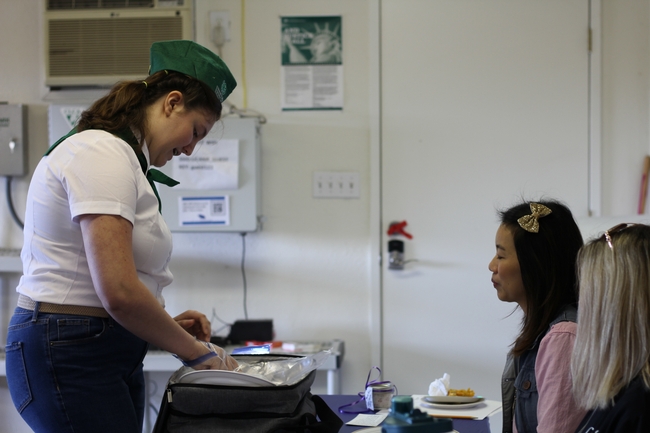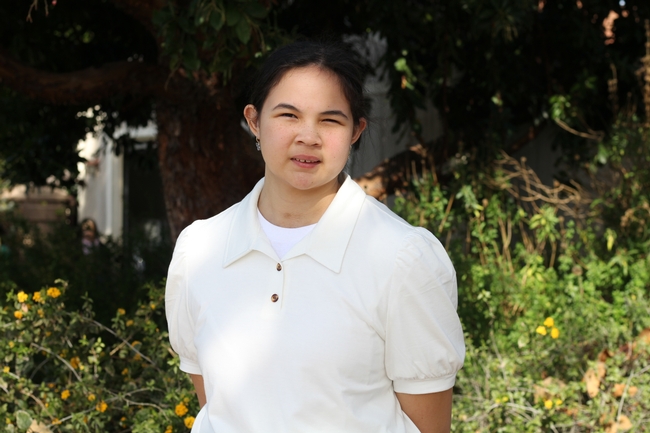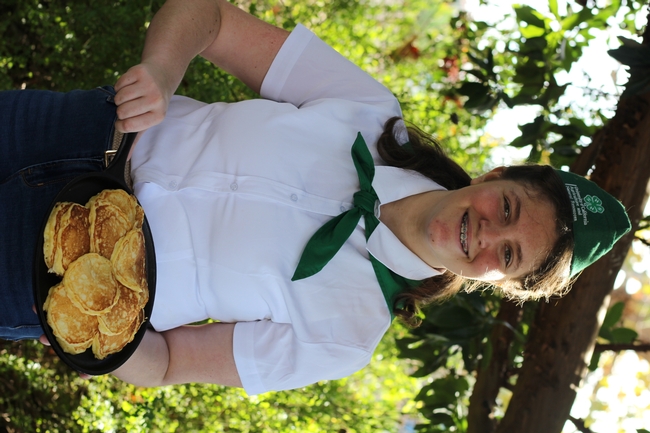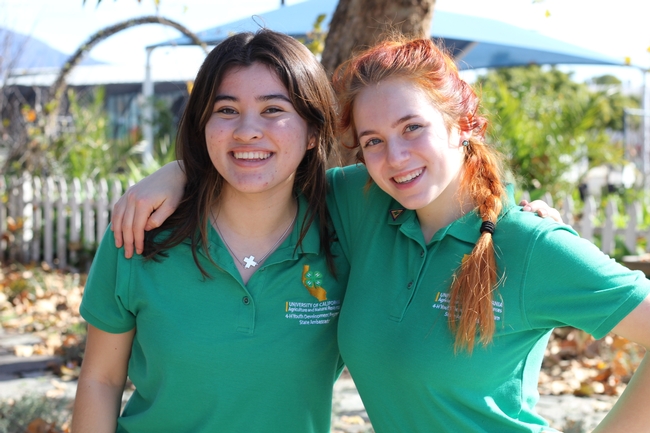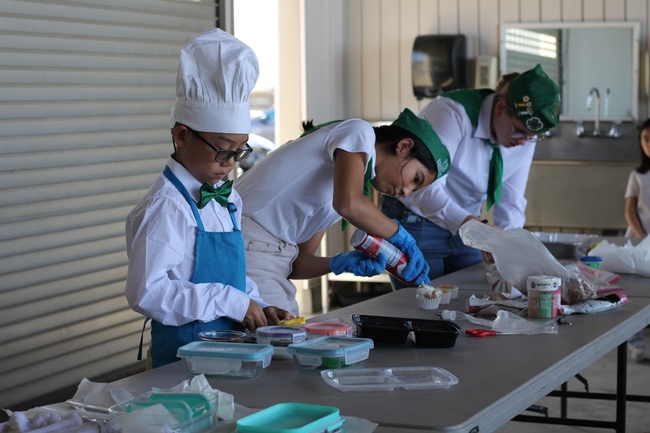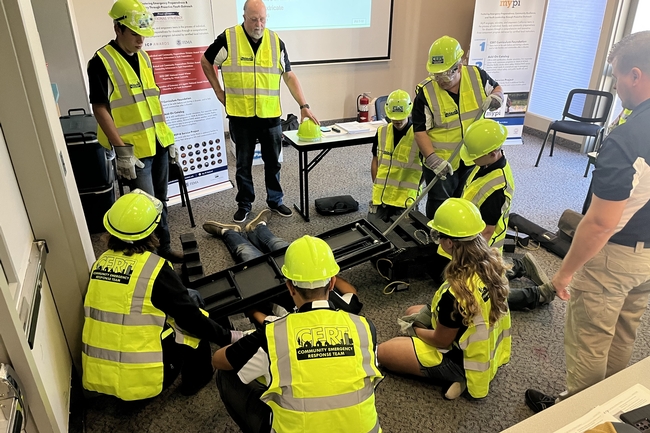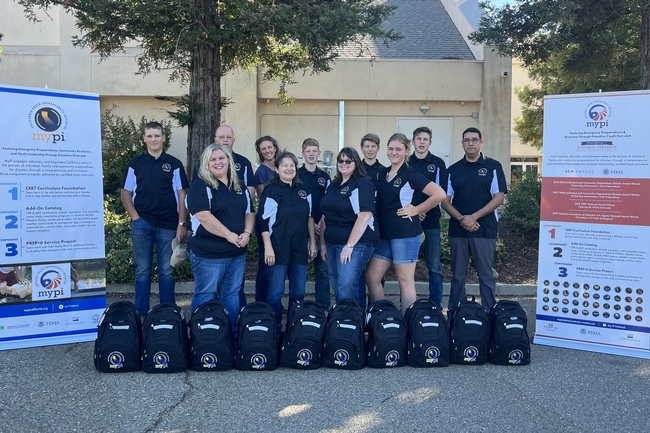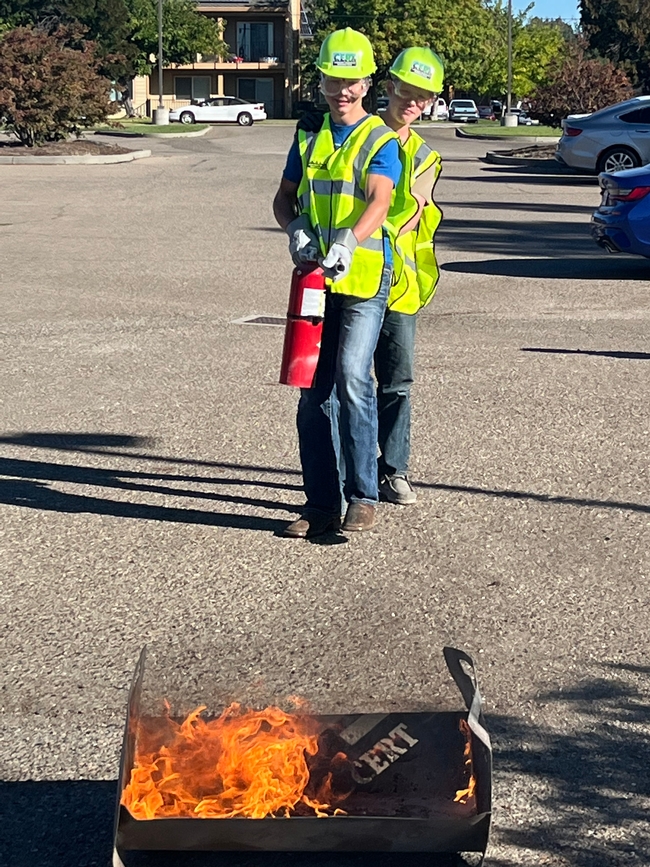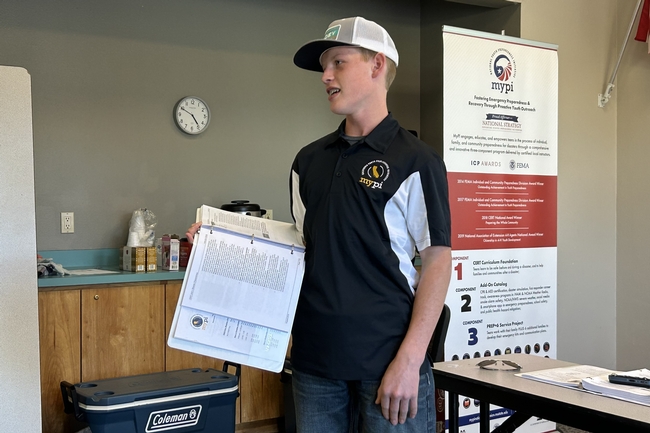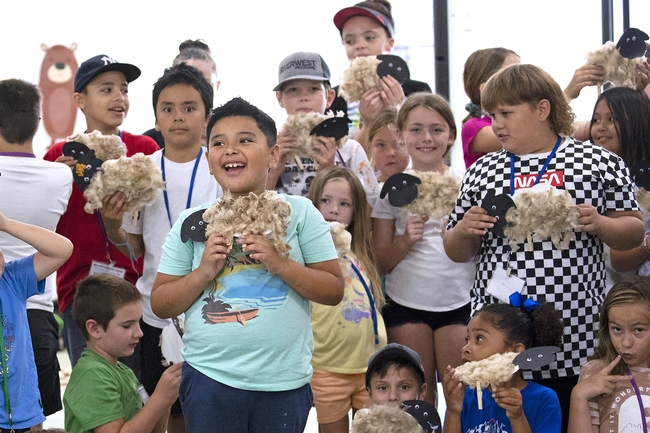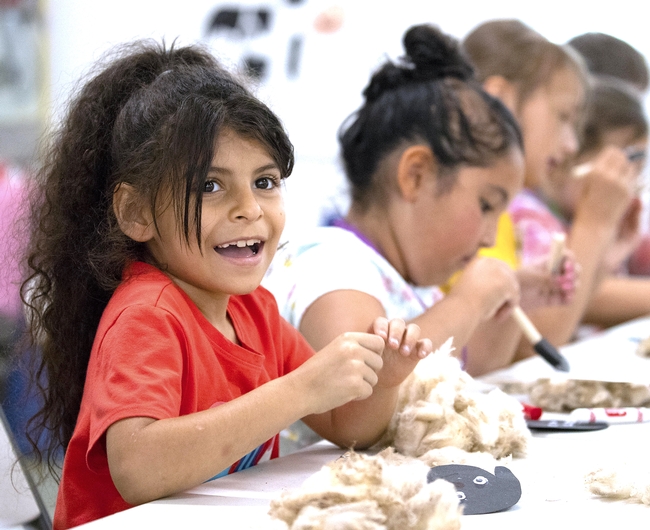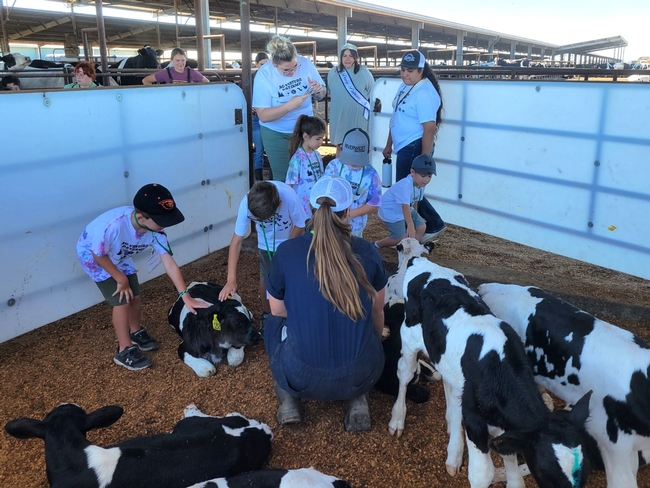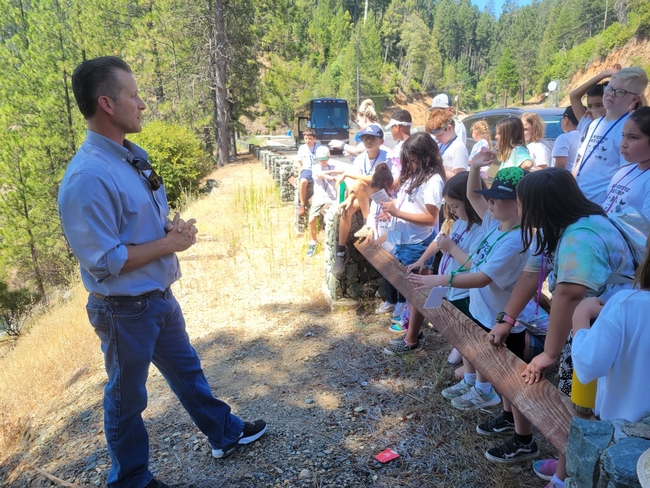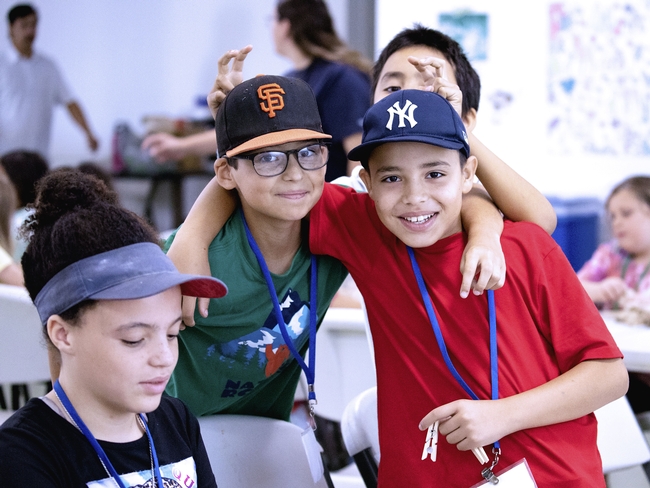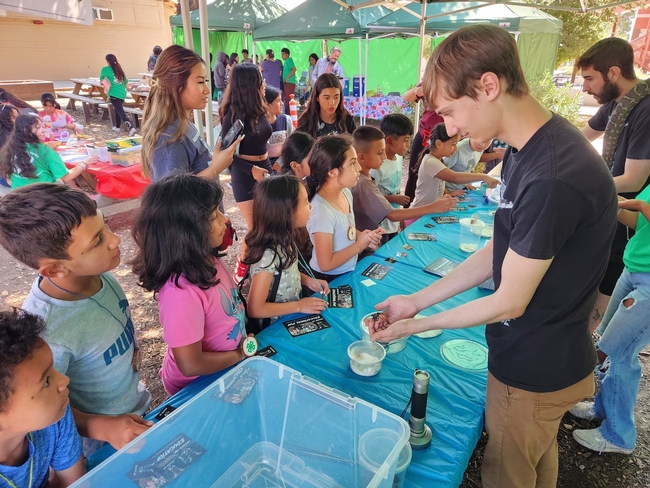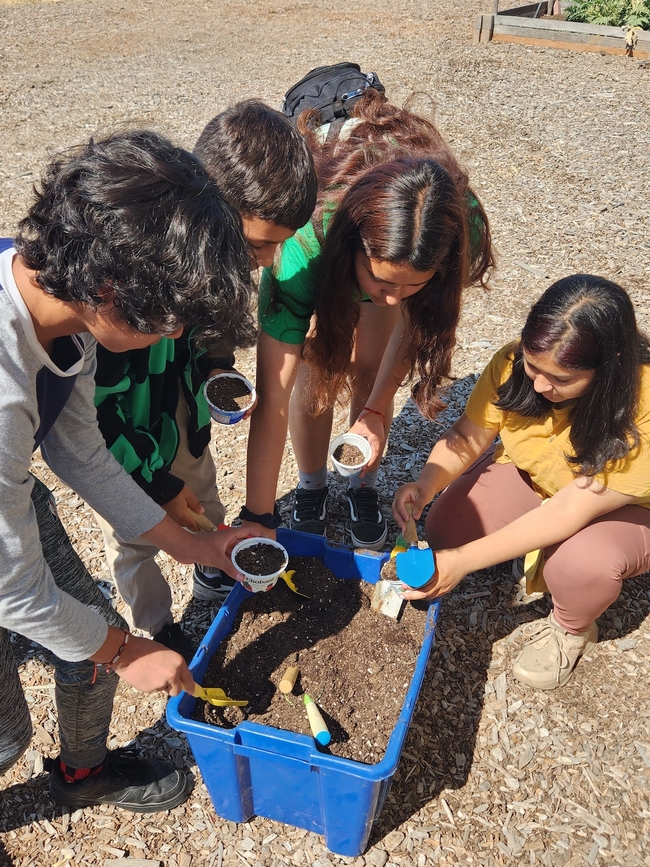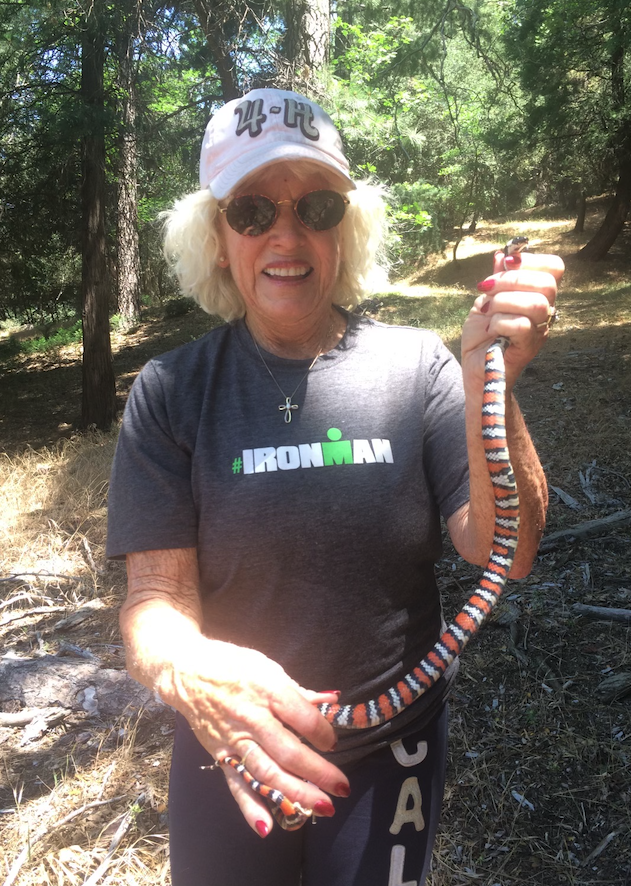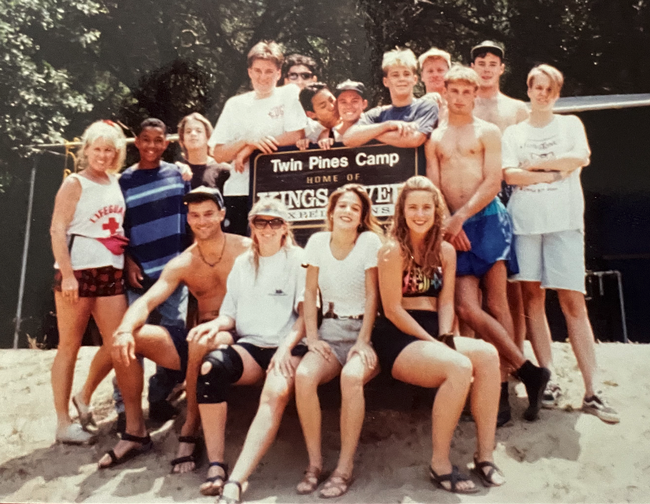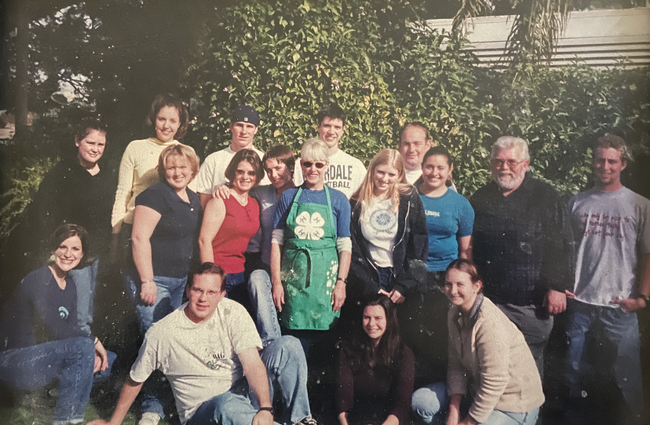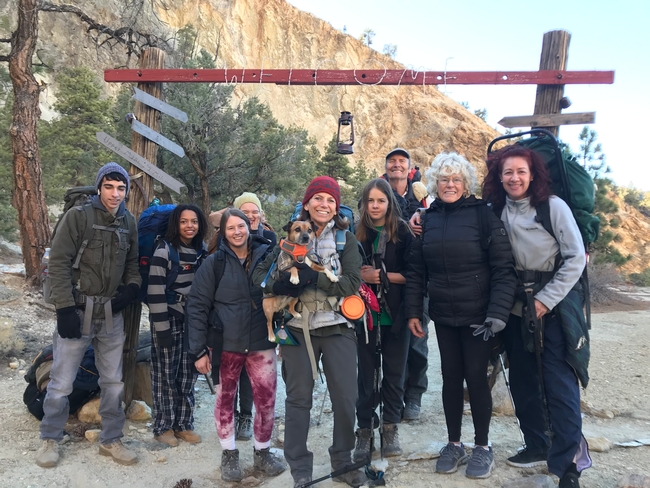Posts Tagged: youth
‘Super Carbolicious’ 4-H Food Fiesta challenges young chefs
Inside a quiet classroom, Sadie, a 4-H member in Orange County, stands in front of two judges with an insulated cooler bag in hand. From it she pulls out plates, utensils and napkins and sets them down on the table. She unzips the bottom compartment and carefully reaches for a cast iron platter with golden fluffy pancakes piled on top.
“Would you like syrup with your pancakes? I highly recommend it,” said Sadie, an eighth grader who is participating in the annual 4-H Food Fiesta for a second time.
4-H, a youth development program supported by the University of California Agriculture and Natural Resources and administered through local UC Cooperative Extension offices, promotes hands-on experiential learning for all youth.
Rita Jakel, 4-H program coordinator for Orange County, described the Food Fiesta event – intended for ages 5 to 18 – as an opportunity to practice and showcase public speaking skills through a fun, food-related competition.
Youth present their creations before a panel of evaluators, who ask them to describe how they prepared the dish and why, and how they managed challenges throughout the process. The interaction between youth and adult leaders provides a unique opportunity for youth to practice career readiness skills such as job interviews and public speaking.
This year's theme was “Super Carbolicious” and 4-H participants were encouraged to make their favorite dishes using ingredients like pasta, potatoes and bread. Carbohydrates are often perceived as unhealthy, which is not a helpful mindset to have when teaching youth about nutrition. Carbohydrates provide the body with glucose, which is converted into energy that people need to function throughout the day.
Some of the dishes that were presented during the Food Fiesta included chocolate chip banana bread, cheesy baked potatoes, cookies and Nutella-stuffed crepes. 4-H member Kaitlin had only ever attended the Food Fiesta to cheer on a friend. This year, she decided to participate and presented pumpkin macaroni and cheese as her entry.
“Pumpkin mac and cheese is better than the regular one because there's a lot more flavor and you have to use two cheeses: cheddar and parmesan,” explained Kaitlin, a seventh grader. When asked what motivated her to participate instead of a being a bystander this time around, Kaitlin said that she wanted to work on her presentation skills.
“Usually, I'm a bit shy and I don't like to share that much. The Food Fiesta helped me practice speaking up more so that I can accomplish my goals,” Kaitlin said.
Sadie, who loves public speaking, admits that it wasn't always a strength of hers. “There was a time when I hated public speaking. But when I joined 4-H's cake decorating, poultry and food fiesta events, I got more comfortable with public speaking,” she said. “Now, I like going to events and showing off. I get to show off turkeys, my cakes and, today, I presented homemade pancakes.”
Helping to keep the day's festivities running smoothly were two 4-H state ambassadors: Michaela and Laurelyn, two high school seniors. Both have been involved in 4-H for over nine years, with Laurelyn being a third-generation 4-H member. “My grandmother grew up in a 4-H club in Orange County. She still raises breeding lambs for 4-H members to this day,” said Laurelyn, whose mother was a 4-H member in San Joaquin County.
As state ambassadors, they are responsible for creating and presenting workshops during state, national and regional events. “We also engage the public via social media, specifically TikTok and Instagram (@4horangeco),” said Michaela, who is in her second year as an ambassador.
During the Food Fiesta, Michaela and Laurelyn made themselves available to answer questions from participants and their families. Both ambassadors agreed that seeing parents involved in 4-H should not come as a surprise. “Being in 4-H is a family effort. This isn't an extra-curricular where you just drop your kids off and leave,” said Michaela.
Laurelyn shared that the biggest misconception others have about 4-H is that they think it's about introducing youth to agriculture or livestock. There's a civic engagement and leadership component to it, too. “If parents knew about all the ways 4-H can benefit their kids, I think more people would want to join us,” she said. “And they're finding fun ways to help us learn life skills, like this Food Fiesta.”
The homemade dishes weren't the only thing to look forward to, however. In another building, Sandy Jacobs, volunteer event coordinator, and her team set up a kitchen quiz for members. On several tables, there were different cooking tools and participants were challenged to name as many tools as they could.
In another classroom, while some members were presenting food, others presented their themed table setting décor. Participants had to prepare a complete table setting entry including a menu card, centerpiece and table settings for two. Judges considered creativity, use of color, table setting etiquette, knowledge in talking to the judges, and appearance in their evaluation.
Finally, to wrap up the day, members competed in a cupcake decorating competition. Participants were responsible for bringing their own supplies including tools and edible decorations for Cupcake Wars. Depending on their age group, participants had 20 minutes to decorate two to four cupcakes, each of a different theme.
To learn more about 4-H in Orange County, visit https://oc4h.org/.
Emergency preparedness program for youth takes root in California
4-H leaders, youth complete state's first MyPI instructor certification workshop in Tehama County
Disasters do not discriminate. They can impact people regardless of their race, color, creed, socioeconomic status – or age. That's why a nationwide effort to train young people in emergency preparedness continues to grow and is establishing itself in California.
The national MyPI (Preparedness Initiative) program, developed by Mississippi State University Extension, partnered with California 4-H this fall to train the state's first cohort of instructors, who will then lead trainings for young people in the coming months. With Northern California as the catalyst, organizers plan to spread the program across the state, said Nate Caeton, 4-H youth development advisor for Shasta, Tehama and Trinity counties.
“If you look at the research, everybody is affected by disasters, but young people even more so, for a number of reasons – whether because they don't fully understand what's going on, or they don't have the same experience or skill sets as adults,” said Caeton, who serves as the MyPI California manager. “But this takes a huge leap in addressing that.”
California is the 28th state/territory-level program to partner with the national MyPI team to train instructors – but the first to allow young people to participate in the three-day instructor workshop.
Of the 11 4-H-affiliated participants who completed the October training in Red Bluff, five were teenagers. The workshop, led by national MyPI trainers, included comprehensive Community Emergency Response Team (CERT) content developed by the Federal Emergency Management Agency, known as FEMA – covering medical operations, fire safety, light search and rescue, disaster psychology and more.
“By the end of day 1, the trainers were already commenting on the maturity level of the teens who had attended,” Caeton said. “They've been doing this training for a long time and they were definitely impressed – that says a lot about our young people.”
Potential disasters necessitate preparation by all
Bodie, a ninth grader in Shasta County, said the MyPI California workshop gave him a new perspective on his father's role and responsibilities as a CAL FIRE battalion chief.
“It was a great class, a great experience,” said Bodie, who participated in the training with his two brothers. “It was a 30-hour-long class – really long, but really fun; there was a lot of hands-on learning.”
Katy Zulliger, Bodie's mother, also attained instructor certification through the workshop. She said that, in their city of Redding and communities across the region, there remains considerable trauma from the devastating fires of 2018 – the Carr Fire and Camp Fire. Zulliger said that educating and preparing the public – including youth – will be crucial in meeting future challenges.
“There's a lot that can happen around here – from earthquakes to fire to flood to mudslides, and the list goes on and on…even, living on I-5, potentially tanker trucks spilling over,” she explained. “It's smart for the kids to learn how to think outside the box.”
Bodie noted that the workshop has made him more aware of his surroundings and potential contingency plans.
“When I'm out in the town, I really do think about what can happen in different scenarios – for example, maybe an earthquake or active shooter situation – and I ask myself, ‘What would I do? How would I respond?'” said Bodie, who is considering a career as a first responder.
Youth have a voice, role in boosting community resilience
The skills and knowledge gained from the MyPI program can equip young people to be leaders among their peers, and even in the broader community, when emergencies arise.
“Kids can actually use this and be engaged – instead of just being a watcher or video taker,” said Zulliger, a 4-H volunteer who has served as a club leader of the Palo Cedro 4-H club. “They have a voice and they can use it positively.”
Her sons – and the other two teens who completed the workshop – will help adult instructors organize and deliver the 10- to 12-week MyPI training to young people in their communities. As part of the program, tentatively slated to begin in Northern California by summer 2024, youth participants will be required to work with their families to create an emergency communications plan, assemble a disaster kit, and reach out to six other households to make similar preparations.
“This gives them some ownership over their own personal preparedness and the preparedness of their family and those they are closest to,” Caeton explained.
By partnering with schools, 4-H clubs and community groups, Caeton said the goal is to deliver the program to 125 young people, across five Northern California counties, by summer 2025 – before expanding participation across the state.
“I'm hoping it spreads like wildflowers, because it's definitely needed,” Zulliger said.
Ag-Venture campers dive ‘head first’ into agriculture, natural resources
UC Cooperative Extension team in Sutter and Yuba counties showcases UC ANR programs, community partners
When dozens of elementary schoolers gathered to watch a live calf birth at Tollcrest Dairy in Yuba County, their comments ranged from “disgusting but cool” to “I saw something that maybe I'm too young to see.”
Expanding horizons, growing knowledge and gently pushing some limits were at the heart of a four-week day camp, Ag-Venture, organized by the University of California Cooperative Extension office serving Sutter and Yuba counties.
Throughout July, more than 80 campers – ages 5 through 12 – explored agriculture and science topics through field trips across the region, hands-on activities and lively presentations by UCCE advisors, UC Master Gardeners, 4-H specialists, UC Master Food Preservers and CalFresh Healthy Living, UC educators. All these groups fall under the umbrella of UC Agriculture and Natural Resources.
A grant from The Center at Sierra Health Foundation funded this day camp for underserved youth focused on agriculture and natural resources – the first of its kind in the area. Exploring the themes of “Interesting Insects,” “Foods and Farms,” “Woods and Water” and “Awesome Animals,” the campers learned directly from community experts and UC ANR scientists.
“Some of the kids might think scientists are only wearing lab coats and working with genetics and DNA and human-based science, but here they got to see agricultural scientists and natural scientists,” said Rayna Barden, the 4-H community education specialist who led the camp. “It was a cool way to showcase what ANR does and what we have to offer.”
Youth gain wide range of experiences, knowledge
Visits to local farms and ranches – with many chances to greet the animals – were a highlight for many of the camp participants.
“I liked learning about agriculture and the interactive activities,” said a fourth grader. “I saw a baby cow coming out of its mama, and they [farm staff] had to use a tool. It was cool.”
A sixth grader said: “I learned that feed is made up of everyday items, like almond shells and beer hops!”
“Sheep, cows and goats have one stomach and four chambers,” added another sixth grader.
That digestive tidbit was absorbed by the campers after a visit with UCCE livestock and natural resources advisor Dan Macon at Sierra Foothill Research and Extension Center, a facility operated by UC ANR in Browns Valley.
“We have 4-H kids and FFA kids in high school who still don't know how the four chambers work!” Barden said. “These kids had it and it was so cool to see that they remembered that from a previous day.”
Time and time again, Barden said she was amazed at how much the campers retained. After a visit to Bullards Bar Reservoir, a seven-year-old was able to explain why the dam is curved. Another young boy could draw his own interpretation of the water cycle. And several campers talked about the rice presentation for weeks.
Whitney Brim-DeForest, UCCE county director for Sutter and Yuba counties and a rice advisor, had the participants touch and feel different rice seeds and varieties. The campers also got to plant a few rice seeds to take home.
“But their favorite part – and what they talked about for the rest of camp – was the tadpole shrimp,” Brim-DeForest said. “We brought some live and preserved specimens, and they loved them!”
Sparking ideas for future careers
One third-grade camper said she enjoyed learning the differences between agricultural pests and beneficial insects.
“And you can do stuff to help the good bugs,” she said, adding that she would like to pursue a career working with animals and nature.
Expanding awareness among young people of new career possibilities was exciting for Ricky Satomi, UCCE forestry and natural resources advisor for Sutter and Yuba counties. Using interactive exercises (such as those developed by California Project Learning Tree, another UC ANR-affiliated program), Satomi shared his knowledge about resource competition, watershed filtration and fire behavior in forest ecosystems.
“It's always a pleasure to introduce students to the natural resources where they live,” Satomi said. “This is particularly critical given the current workforce shortage we face in forestry; I hope their experience at Ag-Venture will spark interest in future forestry careers, where these students can work to better their local forest communities.”
Young people from local colleges and universities also gained invaluable experience during the camp. Four students helped prepare the camp: Yasmeen Castro Guillen (Chico State), Alana Logie (Yuba College), Jayla Pollard (Folsom Lake College) and Adam Yandel (Chico State). Three more helped lead the camp as counselors: Hector Amezcua (Yuba College), Alyssa Nott (Butte College) and Jillian Ruiz (Chico State).
“They did such a fantastic job, mentoring the kids and serving as positive role models, and we have seen tremendous growth in all of them, too – in confidence, skills and knowledge,” said Brim-DeForest.
A true community effort
Barden emphasized that the sweeping scope and in-depth, intertwining lessons of the camp were only possible through broad support from the greater community. Brim-DeForest highlighted the partnership with Yuba City Unified School District, as well as with Sutter County. Camp HQ was in Ettl Hall, a Sutter County building; campers visited the Sutter County Museum; they also met Yuba-Sutter public health officer Dr. Phuong Luu.
Additional collaborators included Melissa Ussery, CalFresh Healthy Living, UC nutrition program supervisor; Rene McCrory, 4-H secretary; Johnny Yang, UC Master Gardener and Master Food Preserver program coordinator; Matt Rodriguez, 4-H youth development advisor; and Nicole Marshall-Wheeler, 4-H youth development advisor.
“Honestly, we could plan all of this, but without the community's support, our program never would have worked smoothly,” said Barden, who grew up in the small town of Sutter. “Having all of our guest speakers, having all the people who were willing to have up to 50 kids on their property – it just shows how much our community is about our youth.”
Brim-DeForest said Sandy Parker, the camp nurse, exemplifies that spirit. A UC Master Gardener and 4-H alumna and volunteer, Parker also invited the campers to her family ranch, where she introduced the children to her farm animals and Great Pyrenees guardian dog.
The campers certainly appreciated the generosity, teamwork and energy that went into Ag-Venture. Barden said that many of the participants originally had only signed up for one or two weeks – but loved the camp so much that they asked to register for more. And she added that the “vast majority” of them said they want Ag-Venture to come back and would attend in the future.
“Our youth are just so resilient and so willing to learn,” Barden said, reflecting on the camp overall. “Whereas adults, we're usually a little more timid at things, these kids just were willing to dive in, head first, and be in that moment and try to take away as much as they could from what they were offered there at camp.”
Latino students shine (and squeal) at 4-H Nature Explorers Day Camp
University of California Cooperative Extension, 4-H Youth Development Program in Santa Clara County partnered with multiple community organizations to hold a 4-H Nature Explorers Day Camp at Escuela Popular Bilingual Academy in East San Jose from July 17 to July 21.
Organizers wanted to reach more participants this year than they had in the inaugural 2022 camp, so they structured the program for different K-8 grade levels to attend on different days. 79 campers participated, which was a 130% increase over the number of campers last year.
“Everything we did during the week was focused on environmental science,” said Susan Weaver, 4-H Regional Program Coordinator. “We partnered with Project Learning Tree, UC Environmental Stewards, UC Master Gardeners and CalFresh Healthy Living, UC– as well as community agencies related to the natural environment.”
Numerous activities engaged the youths such as field trips; demonstrations; and sessions themed around trees as habitats, birds and bugs, and being “leaf detectives.” 4-H Adult Volunteer, Laura Tiscareno, took charge of the hands-on Project Learning Tree sessions. Craft time included making nature-themed wind chimes and spinning paper snakes.
Bilingual teen camp counselors guided small groups of students for the duration of the day camp. In situations where the adult facilitator did not speak Spanish, teens translated information into Spanish for students with less English confidence.
“These kids call me ‘teacher' and it's awesome,” said Rodrigo, one of the counselors. “The camp benefits me a lot because I connect with children and in the future, I can even be a teacher if I wanted to.”
Another counselor, Andrea, learned about communication. “It's a bit different with kids at different age levels,” she said. “Since we had kindergarten through eighth grade, we had to switch our tactics from grade to grade so that they would understand us and we'd be able to understand them. Also learning how to bond with them so that they would pay more attention.
One highlight of the week was a field trip for third through eighth graders to the Master Gardeners location at Martial Cottle Park, where students learned about vermicomposting and made their own individual countertop worm habitat and composter.
Campers especially enjoyed the interactive demonstrations. “My favorite part is going on all the field trips because we went to a garden, and we've been catching worms and doing stuff about worms,” said one student. “It's really fun going on trips.”
Another camper said, “Something I would like to change about camp is having more time here.”
The program culminated in a Nature Camp Festival at Escuela Popular in partnership with community agencies. Youth enjoyed games, meeting reptiles, outdoor science activities, arborist crafts, a “Rethink Your Drink” table to make a fresh fruit drink, tamales, a nacho bar and more.
Representatives from the Silicon Valley Wildlife Center discussed animals that live in local neighborhoods and how the Center supports people to keep the animals safe. Victor Mortari of Vexotic Me talked about and showed snakes, spiders, scorpions, and other creatures, making the kids squeal while learning about them. As a fun added bonus, 4-H Community Educator Zubia Mahmood arranged to have a local team come to teach soccer skills as a healthy living activity.
The event increased the youth's interest in environmental education and involved Latino youth and adults who are new to 4-H – representing a community that has not historically benefited from the 4-H program. The teen teachers also increased their leadership and career readiness skills; post-camp surveys showed that all the teen counselors see 4-H as a place where they can be a leader and help make group decisions. Some campers noted in the survey that they wanted the camp to be every day, all summer!
National 4-H funded the camp in 2022 and 2023, allowing organizers to provide meals, T-shirts, water bottles and other items to foster belonging and promote healthy living. Community partners, crucial to the program's success, included the Boys and Girls Club of Silicon Valley, Escuela Popular Bilingual Academy, Silicon Valley Water and Silicon Valley Wildlife Center.

Teen counselors and campers working on a nutrition activity.
4-H volunteer of 48 years is more motivated than ever
A typical day for Dee Keese starts with a 10-mile walk at 5 a.m. and her morning wraps up with a swim. Although Keese is in her late 70s, her daily routine would not surprise you if you knew what she has been doing for the last 48 years.
For nearly a half-century, Keese has been the 4-H community leader for the Palos Verdes Peninsula (PVP) club in Los Angeles County. A youth development program managed through local University of California Cooperative Extension offices, 4-H uses hands-on learning experiences to empower youth to build self-esteem and connect with their communities as emerging leaders.
“When you're pushing 80, working with young people helps to keep you young,” Keese said.
4-H has been a game changer in many ways
In the 1970s, Keese moved to the Palos Verdes area with her first-born son who had a learning disability. Others treated him differently in school, and it didn't help that he was the new kid in town. A neighbor encouraged Keese to enroll her son in 4-H.
“She told me, ‘You've got to put your son in 4-H so he can feel good about himself,'” explained Keese. “And let me tell you, it changed my life.”
In 1978, two weeks before her fifth child was born, Keese became the 4-H PVP club's community leader and has been in the role ever since.
While reflecting on her earlier days with 4-H, Keese remembered when most members were boys. Girls were not intentionally excluded at the time; clubs just didn't attract them. When girls eventually joined 4-H, it was a game changer.
“All of a sudden, the program shifted focus from solely agriculture and animals to include home economics like cooking and sewing,” Keese said. “Now, all my sons do the cooking in their homes. It's a good thing! Because we're moving away from traditional domestic duties, men and women are sharing roles, as they should be.”
The PVP 4-H club offers activities like archery, sailing, surfing and geocaching. “Everything we do is to help our youth be better as adults, out in the real world and in the workforce,” said Keese. “We're relying on the internet too much. Kids need to get outside and do things.”
Over the years, Keese has taken members – who range in age from 5 to 19 – on numerous hikes in places like Havasupai Indian Reservation and Mt. Whitney. She's taken them kayaking on the Colorado River and, these days, co-hosts old-fashioned card game nights on the weekends with other community members.
As a lifeguard and water safety instructor, Keese gives free training to interested 4-H members to become lifeguards. Training courses usually cost well over $200 per person. “If they're interested, I train them and they have another skill to use. And it benefits our club,” said Keese. “When we have pool parties or beach days, my kids are prepared to step in and help.”
‘She will help anyone and everyone at any time'
Ace Yeck, former president of the PVP 4-H club, met Keese 12 years ago and decided to become a 4-H member when he was in fourth grade, following a convincing conversation with her. “She just kept giving me opportunities,” said Yeck.
Currently a third-year undergraduate at Loyola Marymount University studying entrepreneurship, Yeck credits 4-H for preparing him for college. “I got all my community service and public speaking practice through 4-H. I remember doing beach clean-ups, feeding the homeless, helping out at the Christmas fair, and all kinds of events,” he shared.
During his years with 4-H, Yeck was elected to the state board as an ambassador before he went on to represent 4-H at the national level. “Dee encouraged me every time, so I kept going,” he said.
Keese admitted that her life is so full and fun because of 4-H. Her motivation stems from the growth and progress that her students experience. “My kids let me know when I've done something to impact their life. It keeps me motivated,” she said.
While thinking about the members she's had over the last 48 years, she couldn't help but stress how important it is that they feel safe. Keese recalls one student who is gay and had a challenging time getting his parents to understand because of religious and cultural barriers. “The family's priest called me and told me that this student felt like I was the only one who loved him,” she said.
“I can talk about Dee forever,” said Yeck. “One of her best qualities is that she will help anyone and everyone at any time. She wakes up at 5 a.m. and goes to bed at, like, 10 p.m. During that time, she's always helping people,” he added.
Because Keese comes from a different generation compared to the kids in her 4-H club, she attributes her successful impact to her ability to adapt. “If we want to keep kids in this, we've got to be flexible! And you've got to do things they like. We can't do things the way it's always been done before,” said Keese. “We have to be flexible.”
To Keese, 4-H is not just an opportunity to teach life skills or introduce kids to agriculture. It's a chance for them to build community.
“That's what I think my generation does well, having grown up in the '50s and '60s,” Keese said. “We're all about that communal living.”

